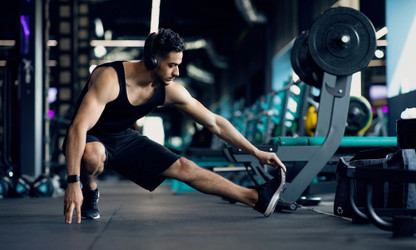The Recovery Hierarchy: What Matters Most
Posted by Medical Research Institute on 22nd Sep 2025
Ice baths, foam rollers, sleep trackers, what's actually moving the needle on recovery?
You crushed your lift. Now what? If your post-workout ritual looks like a buffet of gadgets, supplements, and "biohacks," you're not alone. Recovery culture has exploded in recent years. From ice-cold plunges to compression boots to apps that track your HRV down to the millisecond, the modern athlete has options.
But here's the reality: not all recovery tools are created equal. Some are game changers. Others? Just expensive distractions with a cult following and a cold Instagram aesthetic.
So let's rank what really matters, based on actual impact. We'll break it down into three tiers: the essentials, the performance multipliers, and the gimmicks. And along the way, we'll show where tried-and-true supplements like glutamine and creatine truly shine.
Tier 1: The Non-Negotiables (Do These First)
These are the cornerstones of recovery. Skip these, and no supplement or high-tech toy is going to save your gains.
1. Sleep
It sounds basic, but deep, consistent sleep is the recovery MVP. Growth hormone spikes during deep sleep stages. Muscle repair happens here. Memory consolidation, testosterone production, and tissue rebuilding are all sleep-dependent.
Get 7-9 hours of uninterrupted, quality sleep. Blackout curtains. Cool room. No screens before bed.
2. Nutrition
You can't out-recover a bad diet. Your body needs amino acids, carbs, micronutrients, and hydration to rebuild and recharge.
Post-workout protein is key, but so is a consistent intake of whole foods, fiber, and water. And don't forget the basics: sodium, potassium, magnesium.
3. Training Programming
Recovery starts with how you train. Program intelligently: proper volume, progressive overload, deload weeks, and exercise selection that doesn't fry your CNS. More isn't always better, it's about stimulus management.
Tier 2: The Performance Multipliers (Supplement Wisely)
Once your basics are dialed, you can start layering in strategic tools. Here's where glutamine and creatine earn their reputation.
1. Creatine Monohydrate
This isn't just a performance booster, it helps with recovery too. Creatine restores cellular energy faster post-exercise and reduces inflammation markers after intense training.
It also supports brain health and muscle preservation, especially useful during overreaching phases or when you're in a caloric deficit.
Pro tip: Use micronized creatine monohydrate daily, even on rest days. Consistency builds saturation. MRI's creatine is pure, clean, unflavored, and athlete-approved.
2. L-Glutamine
Glutamine is the most abundant amino acid in the body, and it gets heavily depleted during high-volume training. Supplementing can help:
- Reduce muscle soreness
- Speed up recovery
- Support immune system function (critical when you're training hard)
- Promote gut health...Yes, that matters for nutrient absorption
MRI Performance's L-Glutamine is ultra-clean with no fillers. It's especially useful if you train daily, double-split, or during cutting cycles.
3. Active Recovery
Gentle movement (like walking, swimming, yoga) promotes blood flow without adding stress. It can help you bounce back quicker between training days.
4. Hydration Protocols
Electrolyte balance is a quiet powerhouse of recovery. It's not just about water, you need sodium, potassium, and magnesium to regulate muscle function and energy levels.
Tier 3: The Nice-to-Haves (If You Have the Time and Budget)
These might feel good, but their effects are marginal or dependent on placebo. That doesn't make them useless, just less essential.
1. Cold Therapy / Ice Baths
Yes, they reduce soreness. But they can also blunt hypertrophy signals if used immediately post-lift. Use them sparingly, and never as a replacement for sleep or nutrition.
2. Massage Guns & Foam Rollers
They can improve perceived tightness and provide short-term relief. But they don't fundamentally change tissue recovery. Use them to feel better, not to recover better.
3. Compression Boots
They increase blood flow, but so does walking. Great if you're an elite athlete or recovering from injury. Otherwise? Not a game changer.
4. Sleep Trackers and HRV Monitors
Cool tools for biofeedback junkies. But tracking sleep isn't the same as improving it. If you're waking up tired every day, you don't need a ring to tell you.
The Final Stack: Recovery That Works
When you stack your recovery plan, think in terms of ROI:
- Start with sleep, nutrition, and smart training
- Add supplements like glutamine and creatine to speed things up
- Sprinkle in gadgets and modalities as budget or lifestyle allows
Recovery isn't just about how you feel the next day. It's about staying consistent week after week, year after year. It's what keeps your joints happy, your strength trending up, and your motivation locked in.
And most importantly? It's how you keep making progress without burning out.

